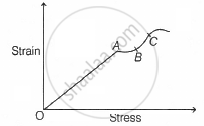Advertisements
Advertisements
प्रश्न
The maximum load a wire can withstand without breaking, when its length is reduced to half of its original length, will ______.
विकल्प
be double.
be half.
be four times.
remain same.
उत्तर
The maximum load a wire can withstand without breaking, when its length is reduced to half of its original length, will remain same.
Explanation:
Because breaking stress = `"Breaking force"/"Area of cross section"`
As breaking force does not depend on length. Thus, changing the cross-section has no effect which implies breaking force remains the same.
APPEARS IN
संबंधित प्रश्न
A mild steel wire of length 1.0 m and cross-sectional area 0.50 × 10–2 cm2 is stretched, well within its elastic limit, horizontally between two pillars. A mass of 100 g is suspended from the mid-point of the wire. Calculate the depression at the midpoint.
When the skeleton of an elephant and the skeleton of a mouse are prepared in the same size, the bones of the elephant are shown thicker than those of the mouse. Explain why the bones of an elephant are thicker than proportionate. The bones are expected to withstand the stress due to the weight of the animal.
A load of 10 kg is suspended by a metal wire 3 m long and having a cross-sectional area 4 mm2. Find (a) the stress (b) the strain and (c) the elongation. Young modulus of the metal is 2.0 × 1011 N m−2.
Answer in one sentence.
Define strain.
Modulus of rigidity of ideal liquids is ______.
Modulus of rigidity of ideal liquids is ______.
A spring is stretched by applying a load to its free end. The strain produced in the spring is ______.
Is stress a vector quantity?
A steel wire having a radius of 2.0 mm, carrying a load of 4 kg, is hanging from a ceiling. Given that g = 3.1πms-2, what will be the tensile stress that would be developed in the wire?
The stress-strain graph of a material is shown in the figure. The region in which the material is elastic is ______.

